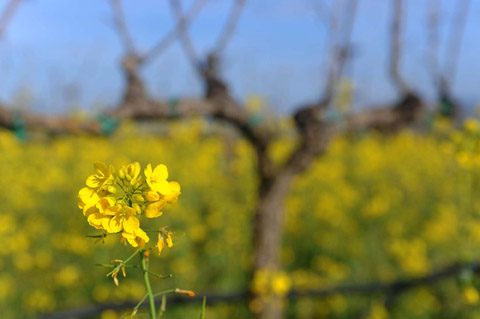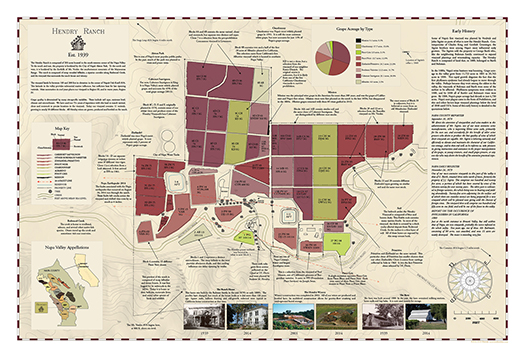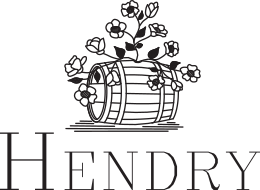Vineyard
SUSTAINABILITY
At Hendry, we have a strong sense of environmental responsibility. We base our choices in the vineyard on a desire to continue farming this land ethically and sustainably, as our family has done here since 1939.
We do not routinely apply any herbicides or pesticides in the vineyard. In addition, we maintain a complex, naturally diverse cover crop to foster healthy, aerated soil and minimize the need for added nitrogen. This minimizes potential nitrogen runoff that could be harmful to our nearby stream and river.

As needed, we may apply potassium and phosphorus to the soil before the first rains of the season to support this cover crop, which in turn, supports the grapes. The remains of the winemaking process--skins, seeds and stems--are plowed back into the soil each harvest. The sulfur we apply in the vineyard is organically derived.
We have not sought, nor do we intend to seek, certification of any kind, choosing instead to follow our own path of best and most responsible practices to maintain a healthy vineyard and environment, while reserving the option to use specific, short term and targeted solutions, organic or otherwise, should an urgent or difficult insect threat appear. Thankfully, this is something that has occurred only a handful of times in the last eight decades.
Please contact us if you would like to discuss any aspect of our vineyard management in greater detail.
--Mike Hendry, Vineyard Manager CONTACT
bLOCKS
The Hendry vineyard is divided into 49 different blocks. Each represents a unique combination of soil type, vine vigor, microclimate, rootstock, clone and variety. The nature of our soils and our location in the valley allow for the production of 11 different varieties, and more than a dozen wines.
 Many of our wines are block designated, whether sourced from a single block, or combinations of blocks with complementary characteristics. The vineyard is constantly evolving, with vines ranging from newly planted rootstock to more than 40 years old.
Many of our wines are block designated, whether sourced from a single block, or combinations of blocks with complementary characteristics. The vineyard is constantly evolving, with vines ranging from newly planted rootstock to more than 40 years old.
Management- A Year in the Vineyard
A year in the vineyard actually ends with the harvest, on the day that the grapes in each block reach their peak of ripeness and flavor. Usually this occurs around six months after budbreak, and four months after bloom. Throughout this time period, complex chemical changes are taking place within the berry. Sugars accumulate, acids decrease, and complex phenolics and aromatic compounds develop. The manner in which these compounds develop, their intensity, and ultimately, the quality of the wine, depends not only on the vineyard, but on the attention that each vine receives through the growing season.
Pruning
Each year in January and February, pruning sets the basic structure of the grapevine and largely determines shoot vigor, crop level and canopy architecture. Each grapevine has a different set of conditions and requirements and pruning is varied within and among blocks individual plants to maintain balance between shoot length and cluster number.
Shoot Thinning
Budbreak marks the beginning of the growing season. With the warm days of spring, shoots begin to grow, and bloom follows quickly. When a grapevine is pruned, a specific number of buds are left to form new shoots. Sometimes two shoots grow from a single bud, and additional shoots called suckers often sprout from other parts of the plant. The process of suckering and shoot thinning ensures correct shoot spacing and number. This contributes to fruit uniformity and allows the right amount of light exposure and air movement through the fruit zone.
Leafing (or “leaf pulling”)
Sunlight, in the right amount, is critical to grape development. Sunlight influences vine fruitfulness, berry size and phenolic development in the grapes. Too much sun can lead to sunburn, too little can produce grapes that are light in flavor and color. The fruit zone on each vine is inspected and, if necessary, leaves and laterals are removed to provide a dappling of direct light on the clusters. This operation is always performed on the morning sun side of the vine thus allowing greater protection on the hotter afternoon sun side.
Crop thinning
Crop thinning can be performed for several reasons. Lighter crop levels generally yield more concentrated fruit. Early in the season, unwanted fruit is removed, or “dropped” in order to achieve the target crop level for each block. Cluster maturity and quality varies within vines as well. Sunburned clusters, clusters on weak shoots, or clusters bunched too tightly together are also removed. Finally, on each grapevine, there are ripe, delicious clusters with complex and concentrated flavors, ready to be picked.



